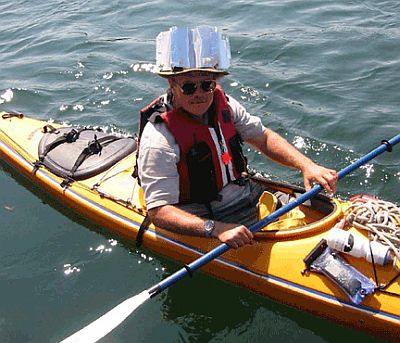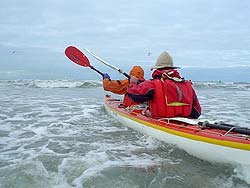- Details
This blogpost is inspired by a growing enthusiasm, within the club where I am member, for kayaking in surf at the coast from Bakkum (Noord Holland); The direct result of having now storage for 5 kayaks at the beach, making it very easy to go paddling for an hour or so.
As I noticed that some new members, being very enthousiastic, keep on paddling although december is coming near, I was a little bit worried about them. Knowing they capsize regularly, I could not resist to warn them for hypothermia and to give some advices.
Having written an extended mail, I thought that the information fits perfect within my weblog and might be of use to somebody else: So that's why I translated the story underneath :
- Details

You have to use all your skills and experience when you have to cross a shipping-lane. Better would be to prevent a foggy-crossing like that.
However when it might be necessary to make such a crossing once, be aware that you depend completely on the radar aboard ships AND the crew which is supposed to keep an eye on the radar.
Your ears are not allways of great help as some ships glide silently through the fog and are close before you notice.
As a kayak is a very low profile vessel, the visibility on a radar is not overwhelming. In the past quite a lot of investigations have been done and what I recall from that is that a choppy sea can make a kayak almost invisible as you are most of the time in between the waves. Even a radar-reflector is not considered as the ultimate solution.
Yet I found on internet that in 2004 an extensive visibility study has been carried out by also "the Maine Association of Sea Kayak Guides and Instructors", "Maine Sea Grant (university)" and "US Coast Guard".
A thorough research went throug different types and sizes of seakayaks, as well quite a lot of radar-reflectors (commercial- and home-made versions)
- Details

At the moment I am busy adding older seakayak-testreports to the website. Working on the Breeze my thoughts went back to discussions, at the time, about the origin of this kayak: Although we were convinced then that the hull was more or less an exact copy of the Ligue de Bretagne (Plasmor) the builder never admitted this.
So when digitalizing the text, I started also looking for information about the Ligue de Bretagne and found out that Plasmor still exists.
The Ligue de Bretagne however is not being built anymore.
- Details

When Hans Heupink, from the Dutch Kayak Association (NKB), asked me if I could arrange a double seakayak to make it possible to take someone from the Department of Transport and water Management around for a seakayaktour in the Voordelta at a spot which is going to be closed for free paddling in august 2008, I did not yet realize that I was the one who should paddle the kayak as well.
Standing at the spot on sunday morning I did not feel honoured, because there was surf at the beach with short steep, breaking waves and in the distance quite a lot of waves with white heads could be seen. No ideal conditions for the maidentrip of a newcomer to seakayaking, I thought.
Normally I would feel quit comfortable in those conditions, but keeping in mind that my passenger did have zero experience in kayaking and that my aim should be to deliver him a pleasant day which should NOT be a survival-day with capsizes in breaking waves, I was worried: Having un unexperienced kayaker aboard, having NO experience myself with this double kayak and not having practised if I could hold the kayak upright on my own in breaking waves.
- Details
 Underneath the report from the Dutch Rescue organisation: they practised at 3 nov. the resue of 5 kayakers from sea: suffering hart-problems and hypothermia.
Underneath the report from the Dutch Rescue organisation: they practised at 3 nov. the resue of 5 kayakers from sea: suffering hart-problems and hypothermia.
KNRM (http://www.knrm.nl)
Noordwijk aan Zee, 4-11-2007T
- Details
I just found a rescue-report about two kayakers in the UK who used an SMS as medium to ask for help. Although there are better ways, it worked and they were rescued.
However, as you can read below, the Coastguard made comments on that.
Maritime & Coastguard Agency (http://www.mcga.gov.uk)
Press Notice No: Duty Press Notice
Saturday, October 27, 2007
Posted 16:26 GMT
- Details
Driving home I was re-thinking the BowRollRescue. At the end I concluded that the technique is not yet finished and could need some finetuning.
Not about the turning-technique: that's perfect.
To my opinion, there is one weak point in the technique. Better said: at the end of the technique.
I think that the victim, once turned up again, could be very, very instable and is very likely to capsize again because of 6 possible reasons:
- Details

I just returned from a 4 day-mini-holiday at Texel; an island in the Netherlands.
The recipy was: camping, much fresh air, long walks through the dunes and on the beach, and a lot of reading.
Refreshing for body and soul!
One of the things I´ve read in the Seakayaker from oktober, I would like to share with you:
It´s about John Marton, a seakayak instructor in the US, who developed a new rescue-technique: the bow-roll-rescue.
- Details
Just read about the accident last sunday near to Vancouver.
Underneath you find the message as published in the papers.
This is a very sad accident; certainly because it could easily have been avoided by wearing wetsuits.
Let it be a lesson to all of us: Hypothermia is life threatening!
ROD MICKLEBURGH
OCTOBER 9, 2007
VANCOUVER
-- For the eight experienced extreme athletes, it was a last rush of adrenaline to mark the end of their adventure racing season, as fall storms began to lash the West Coast.
Kayak to steep Anvil Island in the middle of Howe Sound. Run to the top of the island's peak and down again. Kayak back to the mainland. Bike along 80 kilometres of back trails to Whistler. Run halfway up the mountain, then down at last to a local bar and grill for a celebratory family dinner.
But late Sunday morning, as the four double kayaks began their return journey from Anvil Island, strong winds came up, the waves rose, and tragedy struck. Two kayakers, then two more, were pitched into the frigid waters of Howe Sound.
Yesterday, friends and family mourned the deaths of two of those who began the day in such high spirits, plucked too late from the ocean to survive their severe hypothermia.
- Details
After having enjoyed myself, last spring, in Freya´s workshop on rolling, I did not make an opportunity yet to practise this relaxed way of rolling. This has something to do with the fact that practising only makes sense when paddling a low volume kayak, like my AnasAcuta, in which you can make a layback on the aft deck
It was during last weekend paddling my AnasAcuta that I practised the "floating roll" as I named it: floating because it is the magic to capsize from floating and back to float. As described in my blog the performance was not perfect but it worked. After a few attempts I could not manage anymore: probably because these unused muscles started getting tired.
